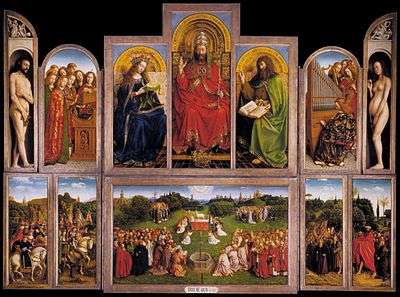Polyptych
A polyptych (/ˈpɒlɪptɪk/ POL-ip-tik; Greek: poly- "many" and ptychē "fold") is a painting (usually panel painting) which is divided into sections, or panels. Specifically, a "diptych" is a two-part work of art; a "triptych" is a three-part work; a tetraptych or quadriptych has four parts; pentaptych five; hexaptych six; heptaptych (or septych in Latin) seven; octaptych eight parts; enneaptych nine; and decaptych has ten parts.

Historically, polyptychs typically displayed one "central" or "main" panel that was usually the largest of the attachments; the other panels are called "side" panels, or "wings". Sometimes, as evident in the Ghent and Isenheim works (see below), the hinged panels can be varied in arrangement to show different "views" or "openings" in the piece. The upper panels often depict static scenes, while the lower register, the predella, often depict small narrative scenes.
Polyptychs were most commonly created by early Renaissance painters, the majority of whom designed their works to be altarpieces in churches and cathedrals. The polyptych form of art was also quite popular among ukiyo-e printmakers of Edo period Japan.
Some medieval manuscripts are polyptychs, particularly Carolingian works, in which the columns on the page are framed with borders that resemble polyptych paintings.
Examples
- The Stefaneschi Polyptych, c. 1320, by Giotto
- The Ghent Altarpiece, completed in 1432 by Hubert van Eyck and Jan van Eyck
- The Last Judgement (Lochner) 1435 by Stefan Lochner
- Polyptych of the Misericordia (1445–1462) by Piero della Francesca
- Polyptych-of-Saint-Augustine by Piero della Francesca
- Beaune Altarpiece (1450) by Rogier van der Weyden
- Saint Augustine Polyptych (1470) by Perugino
- The Saint Vincent Panels (1470–1480) by Nuno Gonçalves
- The Monte San Martino Altarpiece (1471 ca.), by Carlo Crivelli
- St. Dominic Polyptych (1506–1508) by Lorenzo Lotto
- The Isenheim Altarpiece by 1512–1516 Matthias Grünewald
- Cohen's Masterpiece from Bioshock is a quadriptych